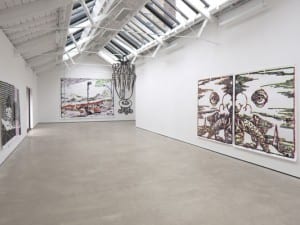In many ways, this new exhibition of sketchbooks at the Hunterian Art Gallery establishes Scottish artist Duncan Shanks as the Robert Macfarlane of paint. Macfarlane, a poet, anthropologist, philosopher of walking and travel writer, has most recently published Landmarks, a book that attempts to preserve and rekindle some of the localised language we use to describe the landscape around us. Shanks’s sketchbooks perform a similar function, and the visual vocabularies he explores of the upper Clyde are compelling: skewed fence posts, bushy clouds, birds, tree roots, branches, trunks and fields. If these form the vocabulary, the grammar is one of pencil, pastel, charcoal and watercolour.
Exploring both softness and sharpness of definition, abstraction and figuration, the sketchbooks are wide ranging and exploratory in technique. However, in subject matter they are incredibly tightly focused, with the bulk of Shanks’s drawing focusing around the Upper Clyde, the hill Tinto, his garden at Davengill and the West Coast Islands. This localised focus is at the conceptual core of his work, which emphasises attention to transformation. Rather like the great haiku master Matsuo Bashō, Shanks’s drawings communicate responsiveness to a landscape that is always changing and in flux.
This is most apparent in a series of weather studies. Across multiple pages of a sketchbook, Shanks shows a rain storm pass over the landscape, observing and describing in his drawings the movement of cloud formations, the subtle changes in light and even it sometimes seems the density in the air. The commitment and patience involved in such a study is combined with the elemental energy that attention to clouds and weather systems naturally conveys.
His garden sketches take the interest in local surroundings even further, and seeing the same environment in so many different lights and depicted in a great many materials is extraordinary. One stand-out sketch from these works is Snow Fall from the Studio, in which confetti-like pastel flecks suggest not just a winter flurry but also a metaphor of falling petals, and the shimmering of sunlight reflected through a window.
In an illuminating essay in the catalogue (published by the estimable Freight Books), Shanks describes a paradox he feels about exhibiting his sketchbooks publically: “I have always believed in the invisibility of the artist when the work alone speaks. It is unforeseen and feels implausible that others might now see in my notebooks the hidden side of my creative process.” It is precisely the private quality of many of these sketches that gives them their fascination and integrity. These aren’t contrived works, but samples of an incredibly deep engagement with the Scottish landscape.
The Poetry of Place: Duncan Shanks’s Sketchbooks and the Upper Clyde, until 16 August, Hunterian Art Gallery, University of Glasgow, Gilmorehill campus.
Colin Herd
Credits
1.Night Garden, 1995-2007, oil on canvas, courtesy of Duncan Shanks.





